The miracle of fermentation
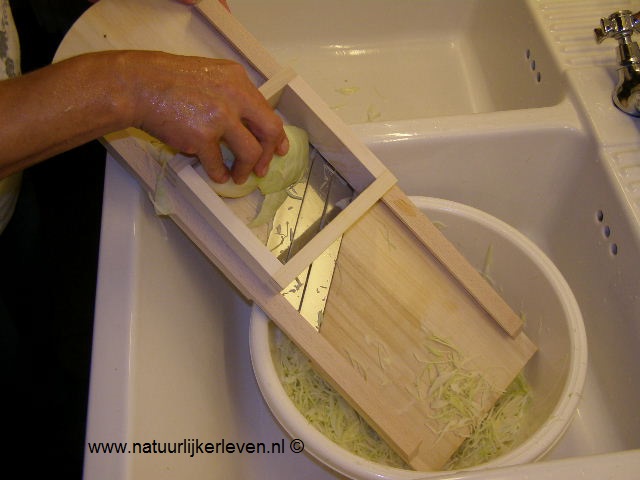
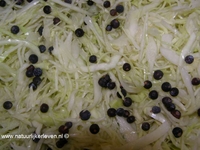 Add the cabbage into small pieces. Add ingredients.
Add the cabbage into small pieces. Add ingredients.
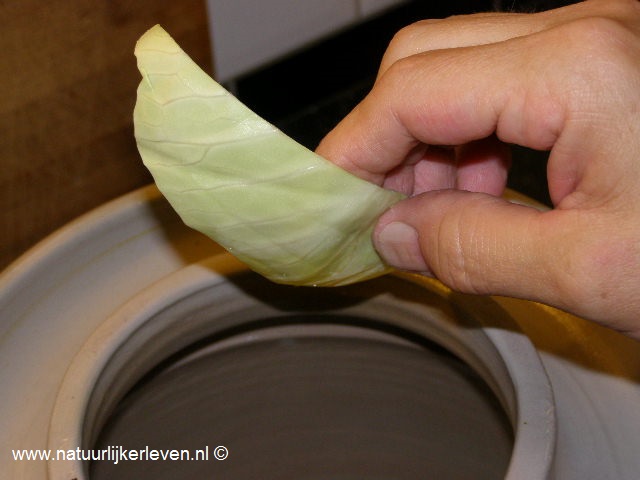
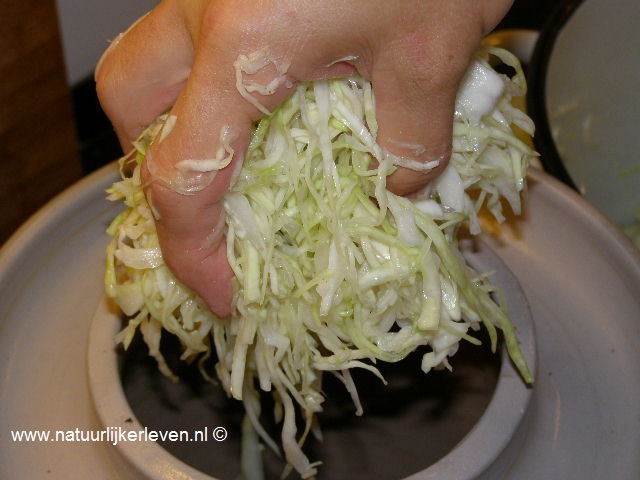 Put leaves on the bottom of the pot. Then fill the jar with the cabbage.
Put leaves on the bottom of the pot. Then fill the jar with the cabbage.
For many centuries, fermentation has been used throughout the world to make vegetables, fruit, milk and meat longer lasting. Sauerkraut was known for China in 5000 years before our year. The Romans took it with them in their field trips, and so we find the first messages about the preparation of sauerkraut and its use against infectious diseases. Around 1800, in Europe, sauerkraut was discovered as a barrier to scurvy, because of the high vitamin C content and long shelf life. Captain Cook lost no one to this feared sea sickness during a three-year voyage, because there was sour on board charcoal. Since the Middle Ages, sauerkraut is known in our regions as public food and in our time it is appreciated as a tasty and healthy winter diet. Traditionally, it is processed into stew, but now also more in raw food.
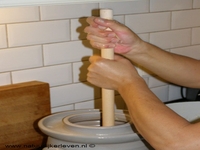
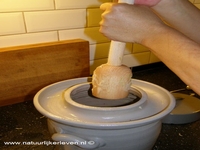
Stamp well between the layers. Use a good pestle to stamp the juice out the cabbage.
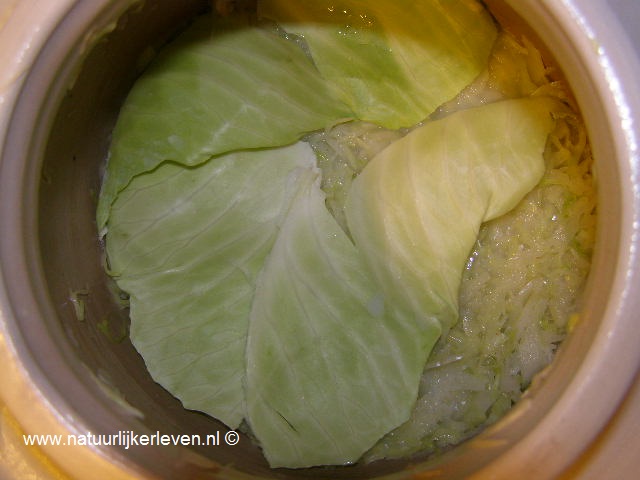
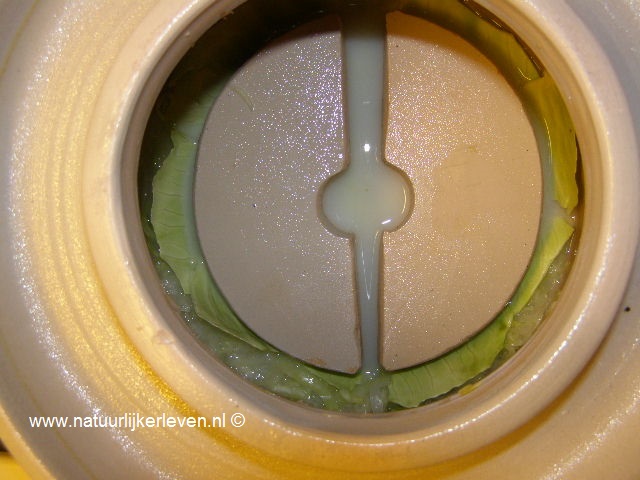
Now cover the Sauerkraut with Add the stones on the cabbage
the cabbage leaves. leaves.
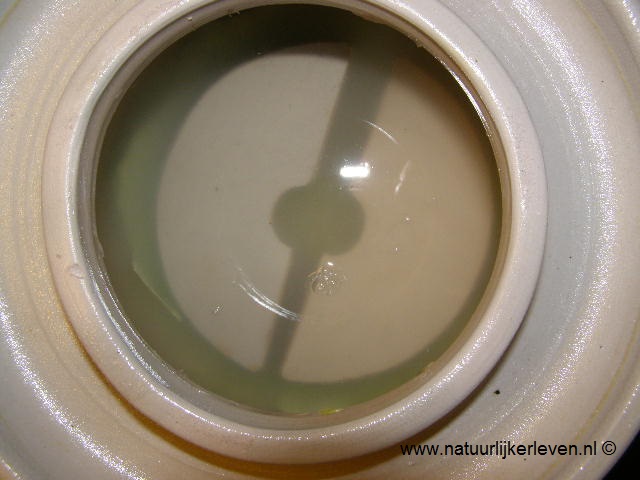
Make sure there is about 2á3 cm
moisture above the stones.
Fermentation pot
The best pot to make sauerkraut is that with a water lock, which has a gulf in the top edge in which the lid fits. The trench is filled with water and acts like a water trap. The advantage of such a pot is that the fermentation process runs smoothly, thus shut off from the outside while the gases released during lactic acid fermentation can escape.
Sauerkraut
The sweeter the cabbage, the nicer the sauerkraut becomes. A combination of white and savoy cabbage gives a softer taste to the sauerkraut. Red cabbage can also be used, red sauerkraut gives the meal a warm and attractive color and is very tasty.
Base recipe sauerkraut
For a 10 liter pot.
- 70 grams of salt
- 25 juniper berries
- 7 kg of cabbage
Mix salt and juniper berries in a bowl. Remove the outer leaves, divide the coal into two and cut the heart out. Cut or grate the cabbage into fine long strips, also grind the heart of the cabbage.
Wash the cabbage and put the cabbage in a large bowl or bucket, add the mixture of salt and juniper berries, mix all the ingredients and leave the mixture for half an hour. The salt makes the moisture free from the cabbage, you can see that too. Fill the fermentation pot low to low with the mixture and press each layer well so that moisture is always over the cabbage. Fill the pot up to 10 cm below the edge. Press the cabbage until there is at least 5 cm of water above it. Cover the cabbage with the outer leaves or with a cheese or tea towel and then the stone to wipe it completely and make sure that there are no small pieces of cabbage floating above and the permanent pressure will keep the cabbage under water: this is essential! Fill the water lock and lay the lid on the pot.
1st stage: Place the yeast pot away for about one week at room temperature (20-22 degrees C) so that lactic acid fermentation can start. Melic acid fermentation has its own characteristic smell, by smell you can determine if the fermentation process has begun.
2nd phase: Once lactic acid fermentation has started, put the flavor pot away in a cool place (4-8 degrees C). After 4 to 6 weeks the sauerkraut is ready for use.
The sauerkraut juice can also be used as a fresh drink or as a starter for a next sauerkraut preparation. Sauerkraut can be stored for a few months, provided it stays under moisture and in a cool place.
Old Dutch Cabbage
- 700 gr of sour apples
- 300 gr onions
- 4 kg of white cabbage
- 2 kg of savoyoil
- 70 g of salt
- 25 juniper berries
- 10 gr ciger seeds (kummel)
Cut or grate the apples and onions into small pieces and mix them with the cabbage.
Trade further as indicated by the basic recipe.
Herbal sauerkraut
- 70 g of salt
- 25 juniper berries
- 5 kg of white cabbage
- 2 kg of savoyoil
- 10 gr cider seeds
- 10 g of coriander seed
- 20 black peppercorns
- 20 yellow mustard seeds
- 10 whole laurel leaves
Further prepare according to the basic recipe.
Fragrant fruit sauerkraut
- 700 gr of sour apples
- 700 gr white grapes
- 6 kg of white cabbage
- 15 cherry or black currant leaves
- 70 g of salt
- 25 juniper berries
Cut or grate the apples and mix them with whole grapes and grated cabbage. Wash the cherry or berry leaves and mix with the salt and the juniper berries. The leaves give a scented aroma to the sauerkraut. Continue the basic recipe.
Red sauerkraut
- 80 gr salt
- 25 whole cloves
- 6 kg red cabbage
- 1 kg sour apple
- Cinnamon
Follow the basic recipe.
Sauerkraut without salt
- 7 kg of white cabbage
- 25 juniper berries
- 10 gr caraway seeds
- 125 gr raisins
- Cooked or distilled water (for replenishing)
- Juice from 3 lemons
It is possible to make sauerkraut without salt, the preparation method is so different from the basic recipe that no salt is used to release the carbon from the coal. After washing and cutting the cabbage, fill the jar directly with the cabbage and herbs, low for low . Sprinkle each layer with raisins. Fill the yeast pot to 10 cm below the edge, squeeze it well and pour the water mixed with lemon juice to 5 cm above the cabbage. Then follow the basic recipe.
Back to prepar food.